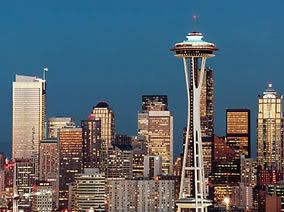
Seattle Press Release
SEATTLE – Calling it the most significant improvement in more than 30 years in how Seattle polices its neighborhoods, Mayor Greg Nickels today rolled out his Neighborhood Policing plan, which adds 154 new patrol officers to Seattle's ranks. Nickels outlined the initiative in his 2007 State of the City address, delivered before a crowd of 500 people as a free presentation of the Rotary Club of Seattle.
The state of the city is “strong and growing stronger,” Nickels declared in his annual address, which focused on making Seattle a leader in the effort to combat climate change. The mayor said addressing challenges such as education, housing and public safety are critical elements of creating the kind of vibrant city that will absorb growth and reduce emissions-producing sprawl.
“Neighborhood policing is a faster, stronger and smarter approach to protecting our neighborhoods,” Nickels said. “Under this plan, we will expand our patrol force to the tune of 154 officers over eight years. But it's not just about adding more officers; it's about putting police officers where they're needed, when they're needed. The result is faster and stronger responses, and smarter use of our resources.”
The plan fixes three problems:
* While the Seattle Police Department meets the commonly accepted response time goal for larger cities, averaging seven minutes for high-priority emergency calls, the average is just that – an average. Response times are faster when the workload is low but exceed seven minutes during the busiest times of the week when 9-1-1 call volume is high.
* There is an imbalance between where patrol officers are deployed and workload, which means officers are not always available when and where they are needed.
* Because of the need to respond to emergency 9-1-1 calls during peak workload periods, patrol officers do not have enough time to work on proactive and specific problem-solving activities.
The plan will:
* Add 154 new patrol officers – 49 have already been added since mid-2005 and another 105 will be added between 2008 and 2012.
* Revise work shifts for patrol officers to match the workload, making officers available at the times and on the days when they are most needed. Since 1997 police officers have worked nine-hour days with rotating schedules of four days on and two days off. The shift start and end times have been basically unchanged for more than 30 years. The city and the Seattle Police Officers Guild are currently discussing alternatives.
* Redraw patrol “beats” throughout the city. The last time beats were redrawn was in the 1970s. The new plan will allow for more balanced, flexible and effective deployment of patrol officers, and will enhance officers' sense of ownership of the neighborhoods they serve.
Calling on the “Seattle Spirit” – a sense of what is possible and a determination to achieve it – Nickels also talked about accomplishments and the challenges facing Seattle.
Global warming pollution
With 418 mayors from across the nation signed on to the U.S. Mayors Climate Protection Agreement to date, Seattle does not stand alone in its goal of reducing emissions by 680,000 tons by 2012. Citing Bridging the Gap and Metro's Transit Now for making it easier to get around the city, and the prevalence of efficient green buildings in Seattle, Nickels said more efforts are on the way, with a public education campaign set to kick off this fall to show people how to reduce their global warming pollution at home, at work and on the road.
“To truly turn the tides on climate change, we will need to commit to reducing our greenhouse gas emissions even more – 80 percent by 2050,” Nickels said.
Education
In 2004, Seattle voters approved the $117 million Families and Education Levy. After one full school year of levy programs, 1,500 children started school ready to learn, stayed in school or improved their grades. Another 4,900 were helped by school-based health centers, and nearly 5,000 children were immunized. Almost all of the levy programs met or exceeded the goals set for the first year. Nickels noted, while it is something to be proud of, it also means that goals must be adjusted for the years ahead.
“Our schools have reached a state of disarray that goes beyond finances – it has become a crisis of confidence. What we need most right now is a new direction – one that provides a vision for how to move forward to create the best education system in the country,” Nickels said.
Housing
New homes and new investments are sprouting up in neighborhoods throughout Seattle – in Ballard, Northgate, Southeast Seattle, and the Center City, where more than 2,000 units are already under construction. The multi-family tax credit has created 800 affordable homes throughout the city. And, Nickels said, the city's housing levy is helping in the fight to end homelessness and to create home-owning opportunities for teachers and other working people.
“People should be able to afford decent housing near where they work. The vision is clear: if you work in Seattle, you should be able to afford to live in Seattle. We have the determination to get there,” Nickels said.
For a full copy of the speech, go to: http://www.seattle.gov/mayor/speeches/stateofcity2007.htm
No comments:
Post a Comment